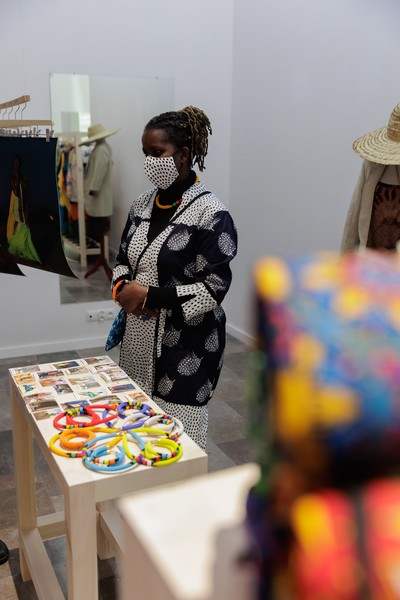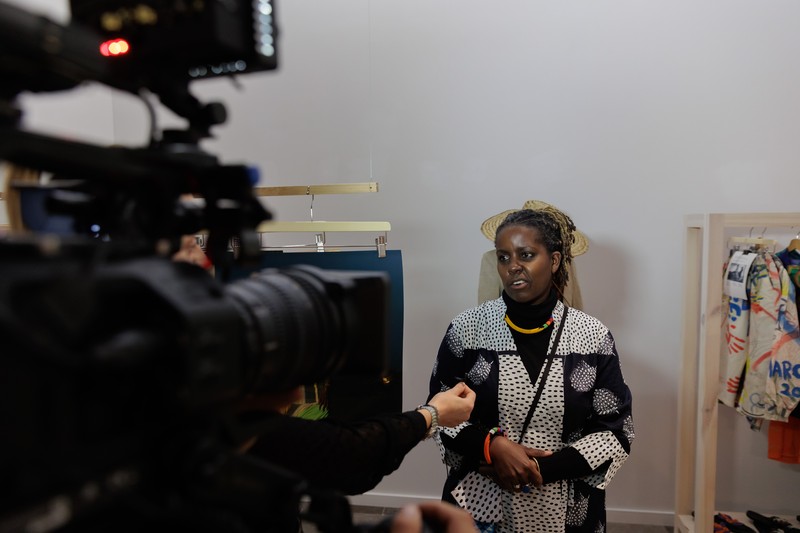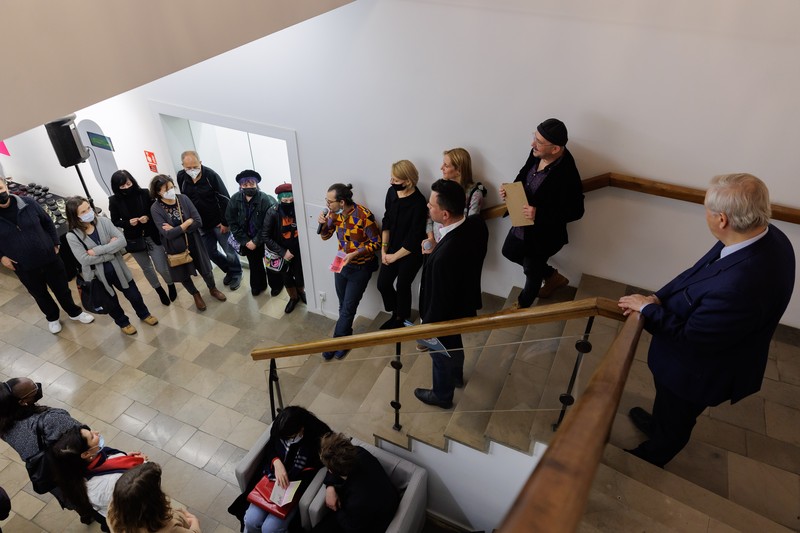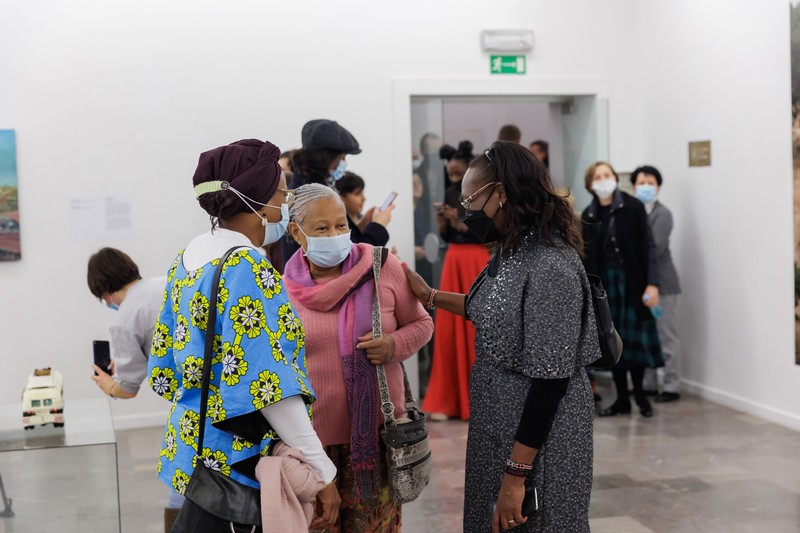The National Museum in Szczecin plays host to TPAAE’s DUOS Festival exhibitions in a combined show that opens in November 2021. Works from iterations themed on Community and Women Power are shown at the NMS Museum of Contemporary Art through January 2022.
The exhibition and related events provides Polish audiences an opportunity to experience projects developed and realised by teams of artists from Kenya and Poland, who made the works for shows in March and September that took place in Kilifi. They can meet with Kenyan artists, who are spending a month in Szczecin on TPAAE exchanges, during the opening and the guided tours.
The Community exhibition offers documentation of a performance based on the origins of the Giriama Revolt of 1913–1914 that choreographer Anna Nowicka realized in collaboration with the Simba Wanga dance group, performance. This duo paid tribute to Mekatilili wa Menza, a grandmother and tribal elder whose opposition to conscription of Giriama tribesman in Britain’s forces during World War I presaged the end of colonial rule in Kenya a half-century later.
Excerpts from a documentary film realized by Małgorzata Mazur and Zippy Kimundu records preparations for the DUOS Festival by the performers of Zaire Ngome Msego Pore. The troupe is made up of community members, who work to preserve Giriama culture through music and dance.
Photographs of a mural created by graffiti artist Piotr Pauk and sign painter Mohamed Mbwena Omar in Mnarani, a Kilifi suburb, also are on display. Painted on the wall of a local elementary school, the work borrows imagery from Kenyan banknotes to convey values of knowledge and labour.
Pieces and photographs from a fashion show produced by photographer Emilia Łapko and designer Wacu Kihara that took place on a Kilifi side street are included in the exhibition. Sewn by local tailors, the pieces created for the show combine Kenya’s traditional khanga fabric and Polish linen.
Community also features a tribute to the coconut palm by photographers Witek Orski and Biko Wesa. Their installation in a hilltop village overlooking Kilifi Creek celebrates the tree’s centrality in Giriama culture.
Painters Zbigniew Rogalski and Richard Onyango present a testimony in painting and sculpture to the power of love that takes fossilised remains of the earliest humans as its starting point. The installation features recreations of bones found in Kenya and pictogram illustration of the stages of modern life to illustrate connections and bonds that perpetuate the species.
Anna Orlikowska and Łukasz Jastrubczak worked with local painter and educator Castro Osore to offer programs, including a trompe l’oeil landscape painted on a wall at the Seahorse Dockers School that local activists Said Chengo and Mramba Mweni are building in their area. Photos document the programmes conducted by DUOS Festival artists for children whose parents cannot otherwise provide for their children’s education.
Within this section of the exhibition, one may also see the books and drawings realized within the KIDS SESSION – a series of collateral workshops that were conducted at Seahorse Dockers School by the educators from the Universitàdi Macerata in Macerata, an Italian partner in TPAAE.
Among the works on show in the Women Power segment of the joint exhibition is an animated retelling of the Mekatilili wa Menza legend made by Iza Plucińska and Sheila Okanga, along with students from Pwani University. The film depicts Mekatilili slapping the district commissioner who killed a chicken that she used to express her opposition to the conscripting of Giriama boys into the British Army. A three-minute etude set to Kilifi poet Shangazi Masika’s “Daughters in Law” accompanies the work and praises love and solidarity among women.
A scale-model mock-up for a sculpture entitled “Ushaha fitswa” (Hidden Treasure), which artists Shaila Resia Agha and Aneta Grzeszykowska conceived to honor the DUOS Festival patron. The artists envision placement of their monumental mask sculpture on the ocean floor near the mouth of Kilifi Creek, where it will provide a habitat for marine life in an area suffering from damage to the coral reef that buffers the area’s Indian Ocean beaches against erosion.
A display of ceramic tiles made by Fauzia Aly Khan and Anna Molska, who together with students from Pwani University decorated a wall at the Seahorse Dockers School that serves the Giriama community. The women exchanged methods and materials, learning one from the other about clays and pigments as they created a porcelain mosaic inspired by traditional Kenyan patterns.
Textiles made from natural fabrics and dyes created by Ciru Karimi and Irena Zieniewicz, who incorporated pigments obtained from leaves, seeds, bark and roots of plants in their works. The work also refers to the environmental protection.
An audio documentation is on display of an opera entitled “Goma Ra Kimbi” (Woman’s Power) that praises female strength and independence. Written and composed by Shangazi Masika and Alicja Pilarczyk, the operatic work sets a libretto that features stories of Kilifi women against a score comprised of classical and popular music, including songs performed by the local “Tumaini” (Hope) choir.
A dance performance fusing ritual and tradition with contemporary club culture that choreographers Faith Kwamboka and Marta Ziółek organized is shown. The duo trained student dancers from Pwani University and enlisted DJs and rappers in a challenging work that slays colonial spirits and confronts tribal taboos in equal measure.
Images and artefacts from a celebration in Street Art of themes and experiences common to women in Kenya also are part of the show. Gathered by artists Linda Shuma and Natalia Szostak from members of the Kesho Kenya educational organization, their stories provided the basis for the stenciled slogans spray-painted on the walls of the Pwani University campus and around the town of Kilifi in an effort to raise awareness about the traditions and determinants that locate women in the country’s male-dominated culture.
A magazine compendium of stories that explore the challenges Kenyan women face on a daily basis and their triumph over personal, social and political adversity is presented. Written by aspiring journalists, writers, bloggers and poets, the MekaZine supervised by Ciro G. and Justyna Machnicka is the flagship publication of the Daughters of Mekatilili collective that members created in Kilifi to represent female artists in the county and on the coast.
Also accompanying the exhibitions of DUOS Festival works is a painting by Said Luganje Kahindi “Girl in African Mask”, which depicts a modern-day image of East African life. Working under the nickname Gendo, the Pwani University student won a competition for young artists organised in the first edition of the DUOS Festival.
Events accompanying the DUOS Festival exhibition at the National Museum in Szczecin are free of charge and include:
- November 4 at 13.00 – meeting with Joyce Kinyanjui, Chief Curator of the National Museum of Kenya in Nairobi, National Museum in Szczecin, Wały Chrobrego (the meeting will be translated from English into Polish)
- November 4 at 19.00 – poetry and music performance by Shangazi Masika and Alicja Pilarczyk with the participation of Zespół Muzyki WspółczesnejAkademii Sztuki w Szczecinie, NMS – Museum of Contemporary Art, Staromłyńska 1
- November 13 at 17.00-18.00 – meeting with artists and curators, guided tour of the exhibition, NMS – Museum of Contemporary Art, Staromłyńska 1
- November 14 at 17.00-18.00 – meeting with artists and curators, guided tour of the exhibition, NMS – Museum of Contemporary Art, Staromłyńska 1
12.11.2021–16.01.2022
Women Power
Artists: Shaila Resia Agha & Aneta Grzeszykowska, Sheila Okanga & Iza Plucińska, Fauzia Aly Khan & Anna Molska, Faith Kwamboka & Marta Ziółek, Ciro G. & Justyna Machnicka, Linda Shuma & Natalia Szostak, Shangazi Masika & Alicja Pilarczyk, Ciru Karimi & Irena Zieniewicz, Jan Smaga,
Community
Artists: Zippy Kimundu & Małgorzata Mazur, Castro Osore & Anna Orlikowska, Wacu Kihara & Emilia Łapko, Mohamed Mbwana Omar & Piotr Pauk, Biko Wesa & Witek Orski, Simba Wanga & Anna Nowicka, Richard Onyango & Zbigniew Rogalski; Mramba Mweni, Said Chengo & Łukasz Jastrubczak, Said Luganje Kahindi, Christian Niccoli
Curators: Marlena Chybowska-Butler, Łukasz Jastrubczak
Cooperation: Ewa Prądzyńska




























